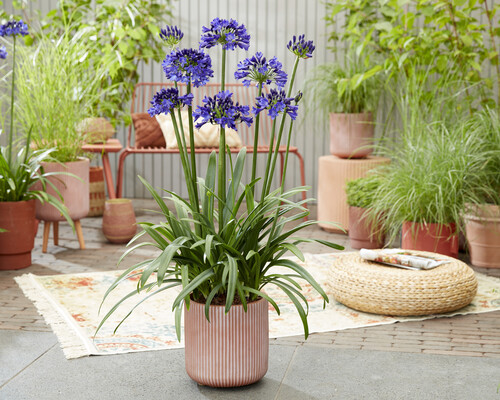Typical Agapanthus Issues and How to Address Them
Typical Agapanthus Issues and How to Address Them
Blog Article
Mastering the Art of Agapanthus Treatment: Important Actions for Healthy And Balanced Growth and Vivid Blossoms
In the world of gardening, the farming of agapanthus stands as a gratifying endeavor for those that seek to support these stylish flowering plants. With their striking blooms and graceful vegetation, agapanthus has recorded the focus of garden enthusiasts worldwide. Nonetheless, achieving optimal growth and lively blooms requires a nuanced method that encompasses various important actions. From selecting the appropriate range to understanding trimming techniques, the journey towards cultivating thriving agapanthus plants is multifaceted and holds the vital to opening the complete potential of these agricultural gems.

Selecting the Right Agapanthus Range

When choosing the appropriate Agapanthus selection for your yard, think about elements such as climate suitability, blossom color, and growth behavior. Agapanthus, commonly referred to as Lily of the Nile or African lily, can be found in a selection of shades ranging from shades of blue and purple to white. Pick a flower shade that complements your existing yard palette to produce an unified landscape. Furthermore, think about the climate in your region to guarantee the Agapanthus selection you choose can prosper in your specific problems. Some ranges are much more tolerant of cool temperature levels, while others choose warmer environments. Recognizing the growth routine of different Agapanthus varieties is critical for proper positioning within your garden. Some ranges have a clumping growth practice, perfect for containers or boundaries, while others have an even more spreading nature, suitable for ground cover or mass plantings. By meticulously examining these aspects, you can pick the perfect Agapanthus range to enhance the appeal of your yard.
Perfect Planting Conditions
Considering the optimal ecological needs is essential for effective Agapanthus farming. Agapanthus prospers in well-draining dirt with a somewhat acidic to neutral pH level. When growing, select a place that gets complete sunshine to partial shade. In hotter environments, providing some mid-day color can protect against scorching of the leaves. Agapanthus plants are sensitive to cool temperatures and must be safeguarded from frost during cold weather.
To ensure healthy and balanced development and dynamic blossoms, plant Agapanthus bulbs at a depth of regarding 2-4 inches and space them 8-12 inches apart. Mulching around the base of the plants helps preserve wetness and suppresses weed development.
Watering and Feeding Tips
Keeping appropriate moisture degrees and supplying important nutrients are vital aspects in the treatment regimen for Agapanthus plants. When it comes to watering Agapanthus, it is essential to strike a balance. These plants prefer constantly wet dirt yet are prone to root rot if have a peek at this site overwatered.
Fertilizing Agapanthus is essential for promoting healthy growth and respected blossoms. Use a balanced plant food, such as a 10-10-10 formula, in the early spring as brand-new development emerges. By complying with these watering and fertilizing tips, you can ensure your Agapanthus plants grow and create lively, lasting flowers.
Trimming Methods for Agapanthus
Pruning Agapanthus plants at the proper times and with proper techniques is critical for maintaining their wellness and promoting optimal development and blooming. The ideal time to prune Agapanthus is in late wintertime or early spring before new growth emerges. Start by removing any type of dead or yellowing pop over to this site fallen leaves near the base of the plant. Cut them as close to the ground as feasible without damaging the emerging shoots.
For flowered stems, wait until the blossoms have actually withered and after that cut them back to the base. This not just tidies up the plant's look yet also motivates the development of brand-new flower buds. Deadheading invested blossoms can additionally reroute the plant's energy into generating even more flowers as opposed to setting seeds. Nevertheless, if you wish to collect seeds for breeding, leave some blossoms to mature and completely dry on the plant.
Keep in mind to use clean, sharp tools to make specific cuts and decrease the danger this content of introducing conditions. Agapanthus. Normal trimming will certainly aid maintain your Agapanthus looking healthy and cool while making certain a bountiful display screen of gorgeous flowers
Managing Typical Bugs and Conditions
After making certain proper pruning techniques for Agapanthus, it is essential to address common parasites and illness that can influence the health and vitality of these plants. One usual bug that affects Agapanthus is the Agapanthus gall midge.
Furthermore, Agapanthus plants can experience from root rot if they are planted in poorly draining soil. By being vigilant and taking punctual activity against bugs and diseases, you can help your Agapanthus plants prosper and produce vivid blossoms. Agapanthus.

Final Thought
Finally, mastering the art of agapanthus care entails picking the ideal selection, providing perfect growing conditions, proper watering and fertilizing, ideal pruning methods, and resolving usual bugs and conditions. By complying with these essential steps, you can make certain healthy development and vibrant flowers for your agapanthus plants. Bear in mind to consistently check and keep your plants to promote their overall wellness and longevity.
To make sure healthy growth and dynamic blooms, plant Agapanthus light bulbs at a depth of concerning 2-4 inches and space them 8-12 inches apart. By complying with these watering and feeding ideas, you can ensure your Agapanthus plants grow and produce vivid, lasting flowers.
One typical bug that influences Agapanthus is the Agapanthus gall midge. Furthermore, Agapanthus plants can endure from root rot if they are grown in inadequately draining pipes dirt. By complying with these essential steps, you can guarantee healthy development and dynamic blossoms for your agapanthus plants.
Report this page